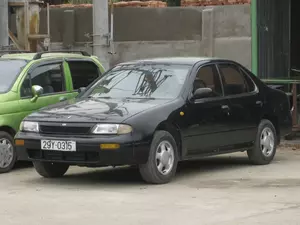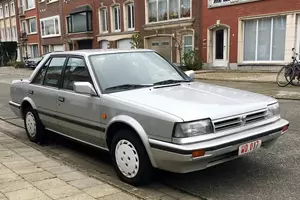
| Vehicle | Precise engine size | Difference from world average | Engine size to consumption ratio | Horsepower from 1 L | Engine size to 100 kg of weight |
|---|---|---|---|---|---|
| 1.5i |
1.5 L (1498 cc) |
36.1% smaller | 48 cc to 1 mpg | 73 hp from 1 L | 125 cc to 100 kg |
| 2.0i |
2 L (1997 cc) |
14.9% smaller | 83 cc to 1 mpg | 67 hp from 1 L | 166 cc to 100 kg |
| Vehicle | 1.5i |
|---|---|
| Precise engine size | 1.5 L (1498 cc) |
| Difference from world average | 36.1 smaller |
| Engine size to consumption ratio | 48 cc to 1 mpg |
| Horsepower from 1 L | 73 hp from 1 L |
| Engine size to 100 kg of weight | 125 cc to 100 kg |
| Vehicle | 2.0i |
| Precise engine size | 2 L (1997 cc) |
| Difference from world average | 14.9 smaller |
| Engine size to consumption ratio | 83 cc to 1 mpg |
| Horsepower from 1 L | 67 hp from 1 L |
| Engine size to 100 kg of weight | 166 cc to 100 kg |

| Vehicle | Precise engine size | Difference from world average | Engine size to consumption ratio | Horsepower from 1 L | Engine size to 100 kg of weight |
|---|---|---|---|---|---|
| 1.6i |
1.6 L (1597 cc) |
31.9% smaller | - | 74 hp from 1 L | - |
| 1.8i |
1.77 L (1769 cc) |
24.6% smaller | 66 cc to 1 mpg | 65 hp from 1 L | 136 cc to 100 kg |
| 2.0i |
2 L (1998 cc) |
14.8% smaller | - | 73 hp from 1 L | - |
| 1.5i |
1.5 L (1498 cc) |
36.1% smaller | 48 cc to 1 mpg | 70 hp from 1 L | 136 cc to 100 kg |
| Vehicle | 1.6i |
|---|---|
| Precise engine size | 1.6 L (1597 cc) |
| Difference from world average | 31.9 smaller |
| Engine size to consumption ratio | - |
| Horsepower from 1 L | 74 hp from 1 L |
| Engine size to 100 kg of weight | - |
| Vehicle | 1.8i |
| Precise engine size | 1.77 L (1769 cc) |
| Difference from world average | 24.6 smaller |
| Engine size to consumption ratio | 66 cc to 1 mpg |
| Horsepower from 1 L | 65 hp from 1 L |
| Engine size to 100 kg of weight | 136 cc to 100 kg |
| Vehicle | 2.0i |
| Precise engine size | 2 L (1998 cc) |
| Difference from world average | 14.8 smaller |
| Engine size to consumption ratio | - |
| Horsepower from 1 L | 73 hp from 1 L |
| Engine size to 100 kg of weight | - |
| Vehicle | 1.5i |
| Precise engine size | 1.5 L (1498 cc) |
| Difference from world average | 36.1 smaller |
| Engine size to consumption ratio | 48 cc to 1 mpg |
| Horsepower from 1 L | 70 hp from 1 L |
| Engine size to 100 kg of weight | 136 cc to 100 kg |

| Vehicle | Precise engine size | Difference from world average | Engine size to consumption ratio | Horsepower from 1 L | Engine size to 100 kg of weight |
|---|---|---|---|---|---|
| 1.8 XE Attesa |
1.84 L (1838 cc) |
21.7% smaller | 74 cc to 1 mpg | 68 hp from 1 L | 141 cc to 100 kg |
| 2.0d |
1.97 L (1974 cc) |
15.9% smaller | 60 cc to 1 mpg | 39 hp from 1 L | 165 cc to 100 kg |
| 1.8 Le grand |
1.84 L (1838 cc) |
21.7% smaller | 68 cc to 1 mpg | 68 hp from 1 L | 153 cc to 100 kg |
| 2.0 SSS-Z |
2 L (1998 cc) |
14.8% smaller | 95 cc to 1 mpg | 95 hp from 1 L | 154 cc to 100 kg |
| 2.0i |
2 L (1998 cc) |
14.8% smaller | 80 cc to 1 mpg | 73 hp from 1 L | 167 cc to 100 kg |
| 1.8 Eprise |
1.77 L (1769 cc) |
24.6% smaller | 63 cc to 1 mpg | 71 hp from 1 L | 147 cc to 100 kg |
| 2.0 SSS |
2 L (1998 cc) |
14.8% smaller | 87 cc to 1 mpg | 73 hp from 1 L | 154 cc to 100 kg |
| 1.8 FE |
1.84 L (1838 cc) |
21.7% smaller | 68 cc to 1 mpg | 68 hp from 1 L | 153 cc to 100 kg |
| 2.0 SSS Limited |
2 L (1998 cc) |
14.8% smaller | 80 cc to 1 mpg | 75 hp from 1 L | 167 cc to 100 kg |
| Vehicle | 1.8 XE Attesa |
|---|---|
| Precise engine size | 1.84 L (1838 cc) |
| Difference from world average | 21.7 smaller |
| Engine size to consumption ratio | 74 cc to 1 mpg |
| Horsepower from 1 L | 68 hp from 1 L |
| Engine size to 100 kg of weight | 141 cc to 100 kg |
| Vehicle | 2.0d |
| Precise engine size | 1.97 L (1974 cc) |
| Difference from world average | 15.9 smaller |
| Engine size to consumption ratio | 60 cc to 1 mpg |
| Horsepower from 1 L | 39 hp from 1 L |
| Engine size to 100 kg of weight | 165 cc to 100 kg |
| Vehicle | 1.8 Le grand |
| Precise engine size | 1.84 L (1838 cc) |
| Difference from world average | 21.7 smaller |
| Engine size to consumption ratio | 68 cc to 1 mpg |
| Horsepower from 1 L | 68 hp from 1 L |
| Engine size to 100 kg of weight | 153 cc to 100 kg |
| Vehicle | 2.0 SSS-Z |
| Precise engine size | 2 L (1998 cc) |
| Difference from world average | 14.8 smaller |
| Engine size to consumption ratio | 95 cc to 1 mpg |
| Horsepower from 1 L | 95 hp from 1 L |
| Engine size to 100 kg of weight | 154 cc to 100 kg |
| Vehicle | 2.0i |
| Precise engine size | 2 L (1998 cc) |
| Difference from world average | 14.8 smaller |
| Engine size to consumption ratio | 80 cc to 1 mpg |
| Horsepower from 1 L | 73 hp from 1 L |
| Engine size to 100 kg of weight | 167 cc to 100 kg |
| Vehicle | 1.8 Eprise |
| Precise engine size | 1.77 L (1769 cc) |
| Difference from world average | 24.6 smaller |
| Engine size to consumption ratio | 63 cc to 1 mpg |
| Horsepower from 1 L | 71 hp from 1 L |
| Engine size to 100 kg of weight | 147 cc to 100 kg |
| Vehicle | 2.0 SSS |
| Precise engine size | 2 L (1998 cc) |
| Difference from world average | 14.8 smaller |
| Engine size to consumption ratio | 87 cc to 1 mpg |
| Horsepower from 1 L | 73 hp from 1 L |
| Engine size to 100 kg of weight | 154 cc to 100 kg |
| Vehicle | 1.8 FE |
| Precise engine size | 1.84 L (1838 cc) |
| Difference from world average | 21.7 smaller |
| Engine size to consumption ratio | 68 cc to 1 mpg |
| Horsepower from 1 L | 68 hp from 1 L |
| Engine size to 100 kg of weight | 153 cc to 100 kg |
| Vehicle | 2.0 SSS Limited |
| Precise engine size | 2 L (1998 cc) |
| Difference from world average | 14.8 smaller |
| Engine size to consumption ratio | 80 cc to 1 mpg |
| Horsepower from 1 L | 75 hp from 1 L |
| Engine size to 100 kg of weight | 167 cc to 100 kg |

| Vehicle | Precise engine size | Difference from world average | Engine size to consumption ratio | Horsepower from 1 L | Engine size to 100 kg of weight |
|---|---|---|---|---|---|
| 2.0D |
1.97 L (1974 cc) |
15.9% smaller | - | 34 hp from 1 L | - |
| 2.0T |
2 L (1998 cc) |
14.8% smaller | - | 105 hp from 1 L | 143 cc to 100 kg |
| 2.0i |
2 L (1998 cc) |
14.8% smaller | - | 73 hp from 1 L | 143 cc to 100 kg |
| 2.4 |
2.39 L (2388 cc) |
1.8% bigger | - | 63 hp from 1 L | 184 cc to 100 kg |
| 1.8i |
1.84 L (1838 cc) |
21.7% smaller | - | 68 hp from 1 L | 153 cc to 100 kg |
| Vehicle | 2.0D |
|---|---|
| Precise engine size | 1.97 L (1974 cc) |
| Difference from world average | 15.9 smaller |
| Engine size to consumption ratio | - |
| Horsepower from 1 L | 34 hp from 1 L |
| Engine size to 100 kg of weight | - |
| Vehicle | 2.0T |
| Precise engine size | 2 L (1998 cc) |
| Difference from world average | 14.8 smaller |
| Engine size to consumption ratio | - |
| Horsepower from 1 L | 105 hp from 1 L |
| Engine size to 100 kg of weight | 143 cc to 100 kg |
| Vehicle | 2.0i |
| Precise engine size | 2 L (1998 cc) |
| Difference from world average | 14.8 smaller |
| Engine size to consumption ratio | - |
| Horsepower from 1 L | 73 hp from 1 L |
| Engine size to 100 kg of weight | 143 cc to 100 kg |
| Vehicle | 2.4 |
| Precise engine size | 2.39 L (2388 cc) |
| Difference from world average | 1.8 bigger |
| Engine size to consumption ratio | - |
| Horsepower from 1 L | 63 hp from 1 L |
| Engine size to 100 kg of weight | 184 cc to 100 kg |
| Vehicle | 1.8i |
| Precise engine size | 1.84 L (1838 cc) |
| Difference from world average | 21.7 smaller |
| Engine size to consumption ratio | - |
| Horsepower from 1 L | 68 hp from 1 L |
| Engine size to 100 kg of weight | 153 cc to 100 kg |

| Vehicle | Precise engine size | Difference from world average | Engine size to consumption ratio | Horsepower from 1 L | Engine size to 100 kg of weight |
|---|---|---|---|---|---|
| 1.6 |
1.6 L (1598 cc) |
31.9% smaller | - | 49 hp from 1 L | - |
| 1.8i |
1.84 L (1838 cc) |
21.7% smaller | - | 60 hp from 1 L | - |
| 1.8 SSS |
1.84 L (1839 cc) |
21.6% smaller | - | 76 hp from 1 L | - |
| 2.0 SSS |
2 L (1998 cc) |
14.8% smaller | - | 70 hp from 1 L | - |
| 2.0 D |
1.97 L (1974 cc) |
15.9% smaller | - | 34 hp from 1 L | - |
| Vehicle | 1.6 |
|---|---|
| Precise engine size | 1.6 L (1598 cc) |
| Difference from world average | 31.9 smaller |
| Engine size to consumption ratio | - |
| Horsepower from 1 L | 49 hp from 1 L |
| Engine size to 100 kg of weight | - |
| Vehicle | 1.8i |
| Precise engine size | 1.84 L (1838 cc) |
| Difference from world average | 21.7 smaller |
| Engine size to consumption ratio | - |
| Horsepower from 1 L | 60 hp from 1 L |
| Engine size to 100 kg of weight | - |
| Vehicle | 1.8 SSS |
| Precise engine size | 1.84 L (1839 cc) |
| Difference from world average | 21.6 smaller |
| Engine size to consumption ratio | - |
| Horsepower from 1 L | 76 hp from 1 L |
| Engine size to 100 kg of weight | - |
| Vehicle | 2.0 SSS |
| Precise engine size | 2 L (1998 cc) |
| Difference from world average | 14.8 smaller |
| Engine size to consumption ratio | - |
| Horsepower from 1 L | 70 hp from 1 L |
| Engine size to 100 kg of weight | - |
| Vehicle | 2.0 D |
| Precise engine size | 1.97 L (1974 cc) |
| Difference from world average | 15.9 smaller |
| Engine size to consumption ratio | - |
| Horsepower from 1 L | 34 hp from 1 L |
| Engine size to 100 kg of weight | - |